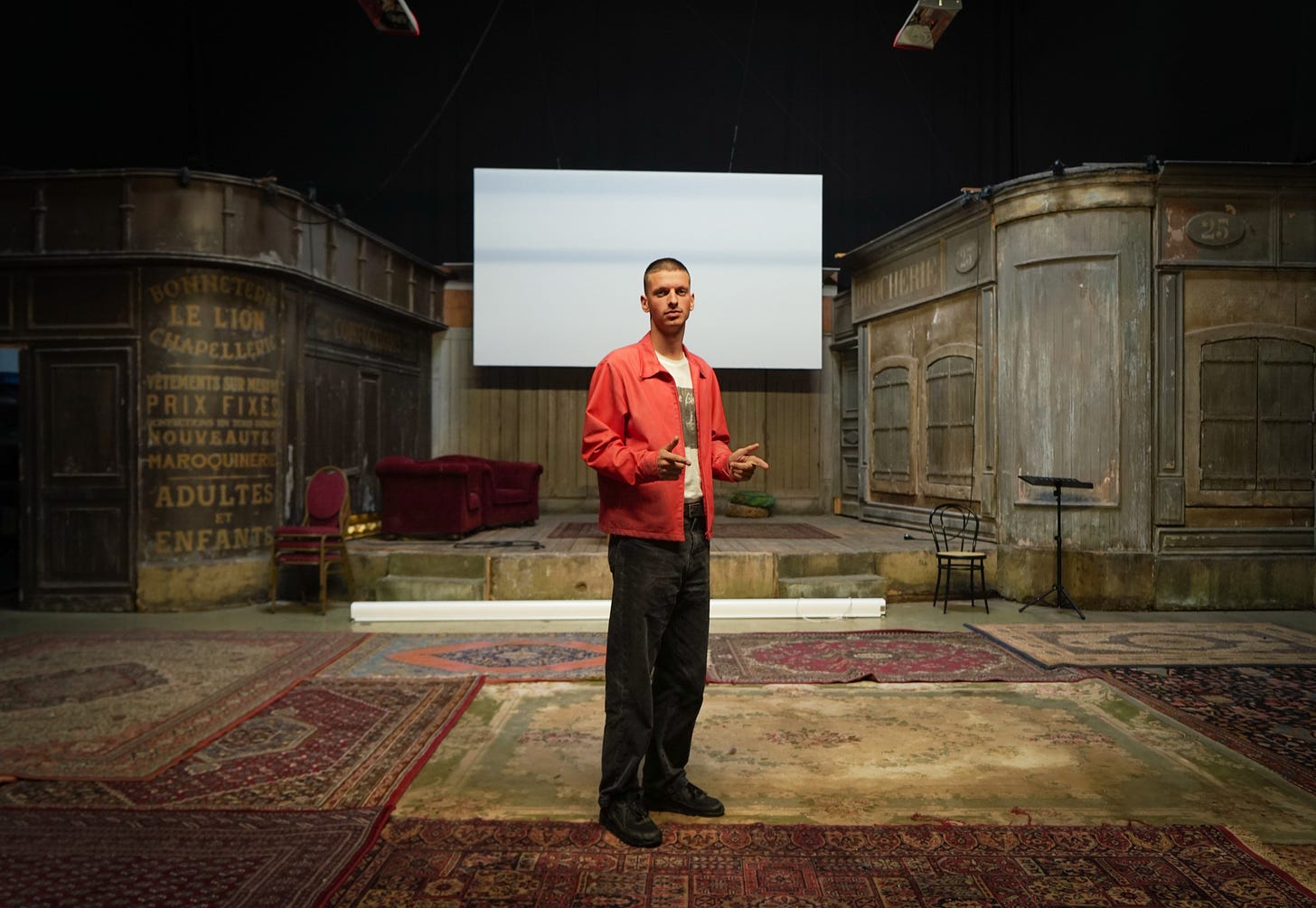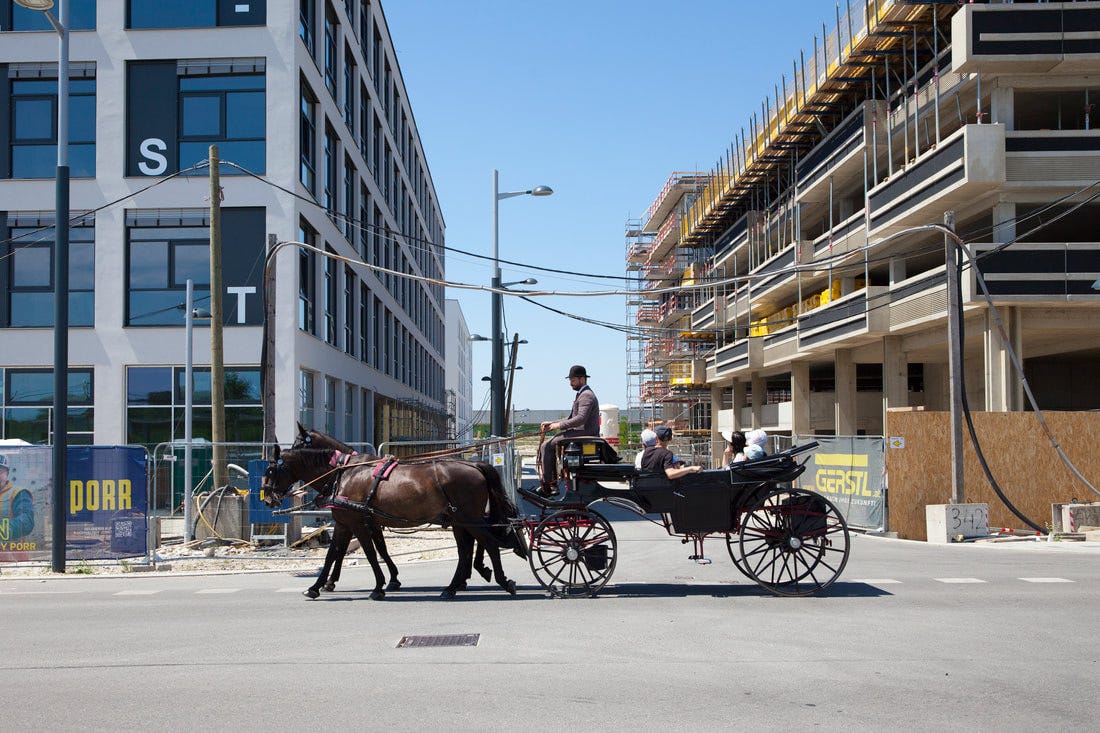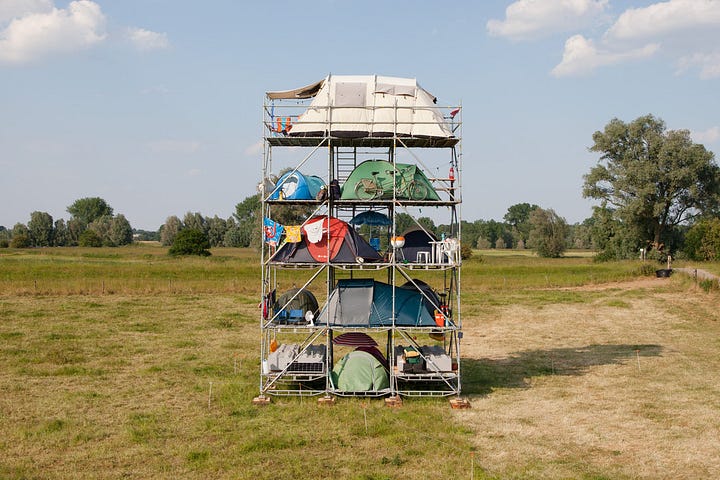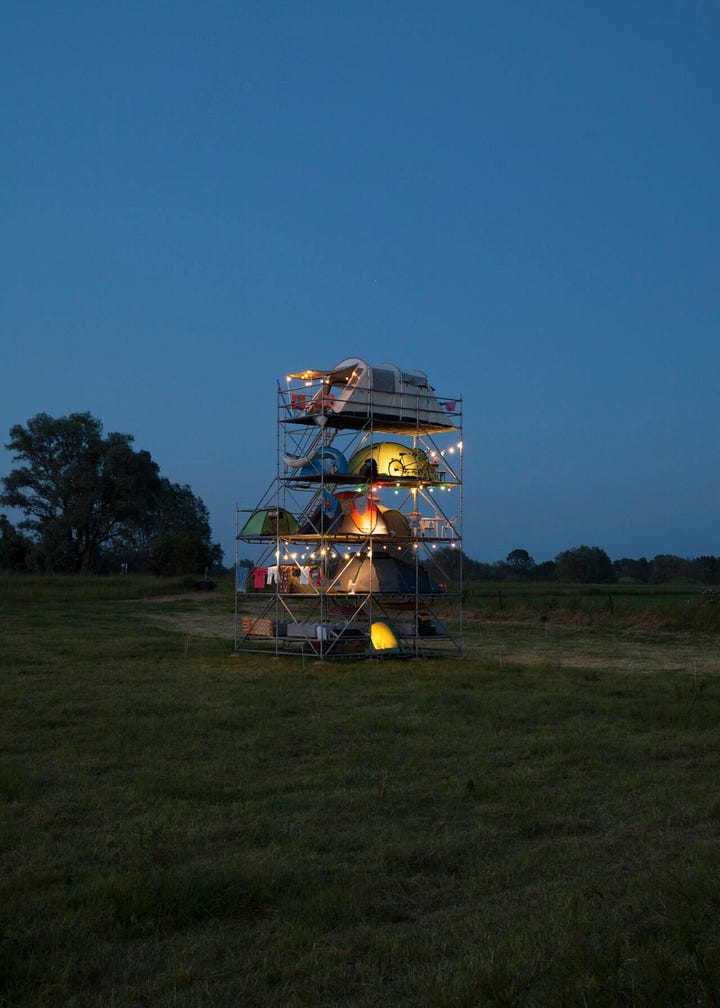#17 Willem de Haan
Willem de Haan is a multidisciplinary artist known for his often slightly absurd and humorous works. His installations revolve around situations that catch his attention in daily life.
"I'm sorry; this isn't very professional," says de Haan as he brushes his teeth before giving me a tour of Antwerp. “This won’t be published right?” Willem guided me through the Blikfabriek, a place reminiscent of Rotterdam’s Keilewerf. Stepping into Willem's studio, de Haan begins by stating, "The studio normally isn't this messy." He then adds, "Oh, look, dixie-dust," referring to the blue-colored dust resulting from deconstructing the dixie installation showcased at an art festival in Tilburg. "I'll send you a photo once it's clean so you'll have proof," he assures. However, I never did receive that photo, so the current state remains a mystery.

How do you start developing your work?
“A lot happens before the idea takes shape. As an example, I was invited to Austria to create a sculpture for a sculpture park in a new city next to Vienna, Seestadt. I proposed spending two weeks there to formulate a plan. I couldn't possibly know what was happening in Seestadt from my kitchen table in Antwerp. It would also be rather arrogant to say, ‘This is what you need,’ about a place I didn't know. So, I went there to discover that the new city had no clear identity yet because there was no history of habitation. This seemed like a stark contrast compared to it’s neighbor Vienna, a city seemingly trapped in its own history, where everything revolves around Mozart and opera, and all the buildings look like decorated cakes. You can't look around without constantly being confronted with the city as remains of the legendary Habsburg Empire. So, it seemed like a fascinating contrast – many young families were moving to the super new city, coming from a place deeply rooted in its history, and suddenly, they’re challenged to formulate a new local narrative.
Eventually, I decided to test what would happen if something iconic from the old city were to come to the new development. I settled on horse-drawn carriages, partly because I noticed that many art scene people from the "old" city came to the sculpture park to see them, but not the residents of the new district. Carriages can move around; you're not confined to the park but can also include the neighborhood. So, I was asked to create a sculpture, and it ultimately became a weekend of horse tours. This then turned into a 7-minute short film, which was a very different outcome than what I was requested to do, but now it was really focused on making an impact. When you want to address a local issue, and the audience are the residents themselves, building a sculpture isn't the way to engage them in this scenario. Putting them in a carriage with a host who asks the residents to share something about the place they inhabit, which at that time was still a kind of construction site, was like writing the first page of that history. But from a three-hundred-year-old carriage. So, to come back to your question, it starts with identifying cultural tension and determining who I want to address and how to capture the attention of that group.”

How did your latest work, the high-rise campground, take shape?
“I'm often asked as an emergency artist because I’m known to work well with very tight deadlines, which was also the case for this years IJssel Biennale. Initially, there was another artist at my spot in the biennial who had a sculpture proposal that was too fire-prone. Then, I received a last-minute call asking if I could create something alternative for that specific location, while the other artists already had their sketches and permits. I started a conversation with the farmer, the owner of the field for which I had to come up with something. He told me how fertile his land was for agriculture and how they produced nature on the other side of the dike. That sounded so odd to me. "Nature production" sounds so unnatural. In his stories, it felt like he was using "nature production" as a political term, very business-like and not ideological. Many cyclists and recreational visitors frequent that location. So, I knew that would be the audience viewing the work. For these cyclists, they feel like they are biking through nature in vast, open, idyllic landscapes with dikes and cows. While the farmer sees it as agricultural land that needs to be as economical and efficient as possible. I wanted to translate that economic efficiency of the landscape to the cyclists by condensing as much camping space as possible into a small area. Eventually, this led to a design that was very urban and deviated from the horizontal landscapes of that place. The Netherlands has the most terraced houses in Europe, so we are a very "low" country, yet even here it's more and more common to have neighbors above and below. So, high-rise is a form that we are actually used to, but now in an environment where you feel like it doesn't belong, even though the efficiency is already happening in the landscape, even if you don't realize it.
After the Biennale, I got a call from NDSM asking if we could move the campsite to their location, a place that was once flat and used for recreation but now has residential towers. Suddenly, putting the same work that clearly connected to the previous landscape in the opposite extreme. What does that do to the image? And what kind of story does the work inform us now? It essentially becomes a new sculpture. At NDSM, I believe it's more about how we inhabit and organize urban spaces. The increasing housing demand exerts pressure on areas designated for recreation. Should these recreational spaces also ascend into the sky akin to residential buildings? This urban trend is already in motion, evident in plans to convert the Red Light District into tower structures at RAI or NDSM. Therefore, a high-rise campground may not be as outlandish as it initially appears. Perhaps it represents the ingenious solution we need. Architectural firm MVRDV, renowned for projects like "Valley" in the Zuid-as and the Boijimans van Beuningen Depot, famously stacked Dutch landscapes in a building for a world expo in 2000.”


What is a previous work you think turned out the best?
"The work I'm most proud of, originated during an event at De Groen Collection in Arnhem. They organized an interview series where a different artist was invited each time to talk about their work. They were interviewed by the artist who had been invited the week before. After each interview, there was a 10-minute performance by a third artist. I was asked to do one of these performances following a conversation between Helmut Smits and Arash Fakhim. On the day of the event, I went to Mediamarkt to buy a printer, brought it to Arnhem, and set it up in the basement below the gallery.
I then sat in on the interview with my phone on my lap, recording the conversation, just like you are sitting here right now. After 10 minutes, I went down to the basement and started transcribing the entire interview they had just conducted, formatting it like a movie script, with every snif and cough meticulously documented. What's funny is that within those 10 minutes of the conversation, a bizarre clash unfolded between the two artists, each with such different perspectives on essential matters that the conversation couldn't gain any depth. Helmut couldn't understand how Arash worked, leading to an awkward tension in the room. The interview just didn't go well. But for my plan, it was genius. Everyone wanted it to be over and was eagerly anticipating some relief from my performance.
I handed the script I had just typed to the artists on stage, and they gradually realized they had to reenact the same 10 minutes all over again. Their initial reluctance turned into a sort of fascination with how this performer guy had captured this script before the talk was even finished. Having to read aloud everything that had just been said, and the tension that had arisen from it, suddenly became quite silly and comical. I don't think I've ever created something so simple that turned out so well in the end. It's rare to hit the mark so perfectly and have it fit the moment."
You can watch the documentation of Willem’s performance here or below, but Willem mentions that the feeling is irretrievable, and you had to be part of the audience to have truly felt that tension. "It's a bit of a shame; my greatest masterpiece was only seen by 40 people. And the likelihood of staging this again and it turning out so well again is near 0.”
Can you tell us what you are going to be up to in Shanghai next month?
“No. ”
Do you want to add anything to this interview?
“Uhh well -”
Some stuff Willem likes and dislikes:
🤠🏇 Yodeling in country music
"I always thought yodeling was only done in the Alps, but I discovered that yodeling sounds are also used in country music. While cowboys are somewhat problematic and romanticized colonial figures. In the movies, the character is about someone traveling around solo on a horse, sort of hopeless. Always feeling like you have a chance to strike gold. But you're not sure, so you just have to try to stumble upon it. Sometimes, I feel that way too when I travel around in my van with my materials, exploring a particular place and having the feeling that there might be artistic gold to find there. That sense of, the lonesome lyrics, combined with those whining yodels in the music, is currently a micro-obsession," he says, laughing.
🚂 Transfers at Breda Station
“I don’t like transfers, but transfers at Breda are even worse. The whole design of the train station is unpleasant to have to wait in. I was just there for 80 minutes before arriving here.”
🎄 Christmas
“I hate Christmas, the whole taking trips to the families aspect is something I really dislike. Every year I spend more time on the road than among loved ones. I also think it’s silly to so massively celebrate a christian holiday, in a country where one seems to practise that religion anymore. Not that we should though. I think religion is a silly thing in general – there are more motivating and less conservatively narrow minded things to hold on to when you’re in need of a hopeful message or structure in your life. A series of christian themed days turned hypercommercial on which you’re expected to over eat and force the best time ever with your family – and then be on the road all day to make it happen? I hope to once get commissioned to design a holiday, it will look very different.”



